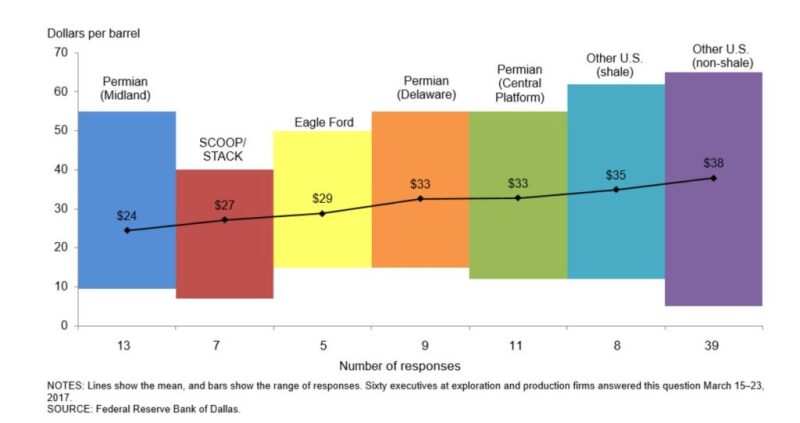With oil prices down again many operators drilling wells in the booming Permian Basin are uncomfortably close to the break-even level, or are even in the red.
The quarterly survey of those in exploration and production business by the Federal Reserve Bank of Dallas found that the oil price required to profitably drill an oil well in the Permian Basin ranges from USD 46 in the Permian’s Midland Basin to as high as USD 50 in its Central Platform area.
Those numbers straddled the benchmark price for US crude of USD 48/bbl at the time the survey was produced.
While the survey is based on the views of people working for 153 operators and service companies covering Texas and parts of three adjoining states, production growth there could have a global impact on prices.
“With the majors and large independent bull-headedly continuing to drill in spite of pricing and increasing inventories, there does not seem to be any upside for prices for the rest of this year and probably none for 2018,” wrote one of the unnamed respondents.
Another commenter saw falling prices ahead because the “price recovery is too fragile and the rig count increase is an illogical response to slightly improved prices.”
As a group, the survey respondents were less pessimistic. When asked to predict the year-end oil price, respondents predicted it would be near a level reached earlier this year, at USD 53.49/bbl. Natural gas prices are expected to be trading at USD 2.95/mcf at the end of the year, unchanged from the price at the time the survey was prepared.
An optimist referred to moves by US President Donald Trump to reduce regulation, saying, “We’re very positive about the direction we’re heading from a regulatory aspect to a business-friendly environment. We do see some bumps along the way with oil prices.”
Another said, “As a small independent, I can’t recall a time when the energy business indicators seemed so mixed and uncertain.”
Spending Limits
When it comes to hiring and raises, exploration and production (E&P) companies are keeping a lid on spending. Only 9% of the exploration and production firms added employees during the first quarter of this year while more than 15% cut jobs.
In contrast, 31% of the companies selling services and supplies added workers while only 9.5% cut jobs. And the hours worked rose at nearly half of the companies, which have responded to the pickup in activity with price increases, which are likely to raise rates for drilling and completion by more than 8% by year end, according to the survey.
| Indicator | % Increasing | % Unchanged | % Decreasing |
|---|---|---|---|
| Employment | 9 | 76 | 15 |
| Employee Hours | 13 | 73 | 14 |
| Wages & Benefits | 27 | 65 | 8 |
Source: Source Federal Reserve Bank of Dallas.
| Indicator | % Increasing | % Unchanged | % Decreasing |
|---|---|---|---|
| Employment | 31 | 60 | 9 |
| Employee Hours | 48 | 38 | 14 |
| Wages & Benefits | 24 | 66 | 10 |
Source Federal Reserve Bank of Dallas.
The range of numbers and comments in the survey showed that the oil business is built of diverse parts.
From company to company, estimated costs for profitably developing and producing wells covered a wide range. While operators in two hot Oklahoma shale plays—the SCOOP and the STACK—can profitably produce at USD 29/bbl, their responses ranged from less than USD 15/bbl to near USD 50/bbl.
The days when unconventional development were assumed to be the high-priced onshore option have changed. The break-even cost for producing from non-shale fields is higher than any of the big unconventional plays surveyed. The cost of drilling and completing non-shale wells is also higher than any of the active plays surveyed in the Fed district, though other US shale plays are higher.
The limited geography of the latest unconventional play was evident in comments like: “There is practically no business for land men unless you move your physical residence to the Midland area.”
Another said: “Earthquake-related regulatory actions and lawsuits killed the appeal of our main operating base, Oklahoma. These same actions have hurt the market value of assets being sold there… (gas sells for less)...Access to capital remains poor ….Continuity of micro-independents is questionable.”



